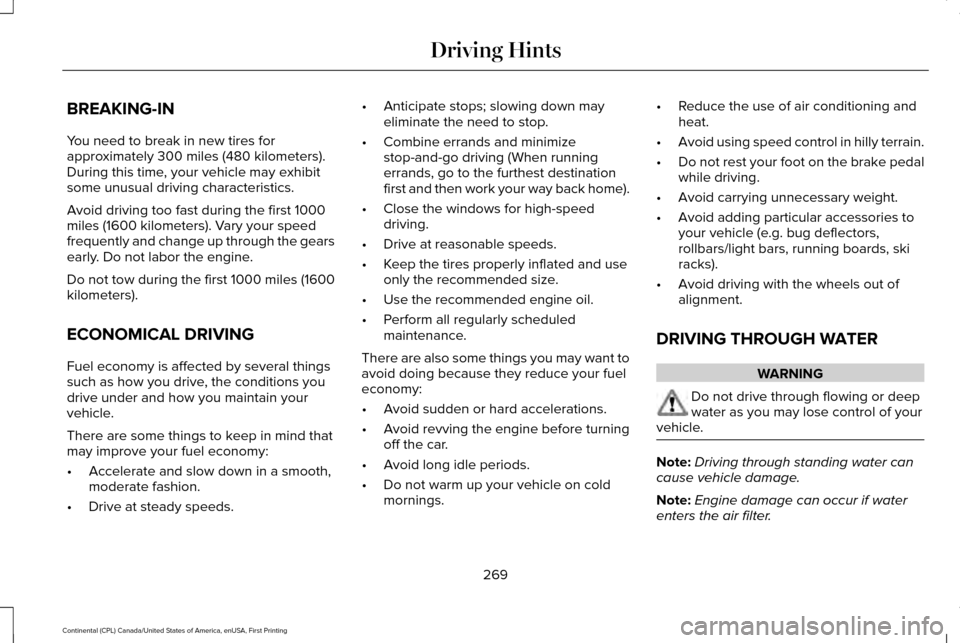2017 LINCOLN CONTINENTAL adding oil
[x] Cancel search: adding oilPage 272 of 584

BREAKING-IN
You need to break in new tires for
approximately 300 miles (480 kilometers).
During this time, your vehicle may exhibit
some unusual driving characteristics.
Avoid driving too fast during the first 1000
miles (1600 kilometers). Vary your speed
frequently and change up through the gears
early. Do not labor the engine.
Do not tow during the first 1000 miles (1600
kilometers).
ECONOMICAL DRIVING
Fuel economy is affected by several things
such as how you drive, the conditions you
drive under and how you maintain your
vehicle.
There are some things to keep in mind that
may improve your fuel economy:
•
Accelerate and slow down in a smooth,
moderate fashion.
• Drive at steady speeds. •
Anticipate stops; slowing down may
eliminate the need to stop.
• Combine errands and minimize
stop-and-go driving (When running
errands, go to the furthest destination
first and then work your way back home).
• Close the windows for high-speed
driving.
• Drive at reasonable speeds.
• Keep the tires properly inflated and use
only the recommended size.
• Use the recommended engine oil.
• Perform all regularly scheduled
maintenance.
There are also some things you may want to
avoid doing because they reduce your fuel
economy:
• Avoid sudden or hard accelerations.
• Avoid revving the engine before turning
off the car.
• Avoid long idle periods.
• Do not warm up your vehicle on cold
mornings. •
Reduce the use of air conditioning and
heat.
• Avoid using speed control in hilly terrain.
• Do not rest your foot on the brake pedal
while driving.
• Avoid carrying unnecessary weight.
• Avoid adding particular accessories to
your vehicle (e.g. bug deflectors,
rollbars/light bars, running boards, ski
racks).
• Avoid driving with the wheels out of
alignment.
DRIVING THROUGH WATER WARNING
Do not drive through flowing or deep
water as you may lose control of your
vehicle. Note:
Driving through standing water can
cause vehicle damage.
Note: Engine damage can occur if water
enters the air filter.
269
Continental (CPL) Canada/United States of America, enUSA, First Printing Driving Hints
Page 316 of 584

2. Run the engine until it reaches normal
operating temperature.
3. Make sure that your vehicle is on level ground.
4. Switch the engine off and wait 15 minutes
for the oil to drain into the oil pan.
Checking the engine oil level too soon
after you switch the engine off may result
in an inaccurate reading.
5. Open the hood. See Opening and
Closing the Hood (page 306).
6. Remove the dipstick and wipe it with a clean, lint-free cloth.
See Under Hood
Overview (page 310).
7. Replace the dipstick and remove it again
to check the oil level.
See Engine Oil
Dipstick (page 312).
8. Make sure that the oil level is between the maximum and minimum marks. If the
oil level is at the minimum mark, add oil
immediately.
See Capacities and
Specifications (page 378).
9. If the oil level is correct, replace the dipstick and make sure it is fully seated. Note:
Do not remove the dipstick when the
engine is running.
Note: If the oil level is between the
maximum and minimum marks, the oil level
is acceptable. Do not add oil.
Note: The oil consumption of new engines
reaches its normal level after approximately
3,100 mi (5,000 km)
.
Adding Engine Oil WARNING
Do not remove the filler cap when the
engine is running.
Do not use supplemental engine oil additives
because they are unnecessary and could
lead to engine damage that may not be
covered by the vehicle Warranty. Only use oils certified for gasoline engines
by the American Petroleum Institute (API).
An oil with this trademark symbol conforms
to the current engine and emission system
protection standards and fuel economy
requirements of the International Lubricants
Specification Advisory Committee (ILSAC).
To top up the engine oil level do the
following:
1. Clean the area surrounding the engine
oil filler cap before you remove it.
2. Remove the engine oil filler cap.
See
Under Hood Overview (page 310). Turn
it counterclockwise and remove it.
313
Continental (CPL) Canada/United States of America, enUSA, First Printing MaintenanceE142732
Page 577 of 584

Coolant Change...................................................317
Engine Coolant Temperature
Management....................................................318
Fail-Safe Cooling..................................................317
Recycled Coolant................................................316
Severe Climates...................................................317
Engine Immobilizer See: Passive Anti-Theft System........................79
Engine Oil Check...........................................312 Adding Engine Oil...............................................313
Engine Oil Dipstick - 2.7L EcoBoost™.......312
Engine Oil Dipstick - 3.0L EcoBoost™.......312
Engine Oil Dipstick - 3.7L............................312
Engine Specifications - 2.7L EcoBoost™ ....................................................368
Drivebelt Routing................................................368
Engine Specifications - 3.0L EcoBoost™....................................................369
Drivebelt Routing................................................370
Engine Specifications - 3.7L
........................371
Drivebelt Routing.................................................371
Entertainment................................................430 AM/FM Radio.......................................................432
Apps.......................................................................443
Bluetooth Stereo or USB...................................441
CD (If equipped)..................................................440
HD Radio ™ Information (If Available)..............436
SIRIUS® Satellite Radio (If Activated).............432 Sources..................................................................431
Supported Media Players, Formats and
Metadata Information....................................443
USB Ports..............................................................443
Environment......................................................16
EPB See: Electric Parking Brake.............................202
Essential Towing Checks
...........................265
Before Towing a Trailer.....................................266
Hitches..................................................................265
Launching or Retrieving a Boat or Personal
Watercraft (PWC)............................................266
Safety Chains......................................................265
Trailer Brakes......................................................265
Trailer Lamps.......................................................265
When Towing a Trailer......................................266
Event Data Recording See: Data Recording..............................................9
Export Unique Options...................................14
Exterior Mirrors
................................................97
360-Degree Camera............................................99
Auto-Dimming Feature........................................99
Auto-Folding Mirrors............................................98
Blind Spot Monitor..............................................100
Fold-Away Exterior Mirrors.................................98
Heated Exterior Mirrors.......................................99
Integrated Blind Spot Mirrors............................99
Lincoln Welcome Mat..........................................99 Memory Mirrors.....................................................99
Power Exterior Mirrors.........................................97
F
Fastening the Seatbelts................................35 Rear Inflatable Seatbelt.......................................37
Seatbelt Locking Modes.....................................36
Using Seatbelts During Pregnancy..................35
Floor Mats
......................................................270
Front Parking Aid..........................................212
Obstacle Distance Indicator.............................213
Front Passenger Sensing System...............47
Fuel and Refueling
........................................176
Fuel Consumption.........................................182
Calculating Fuel Economy................................182
Filling the Fuel Tank............................................182
Fuel Filler Funnel Location..........................178
Fuel Filter
........................................................324
Fuel Quality.....................................................177 Choosing the Right Fuel....................................177
Fuel Shutoff
....................................................273
Fuses...............................................................287
Fuse Specification Chart............................287 Passenger Compartment Fuse Panel...........297
Power Distribution Box.....................................287
574
Continental (CPL) Canada/United States of America, enUSA, First Printing Index